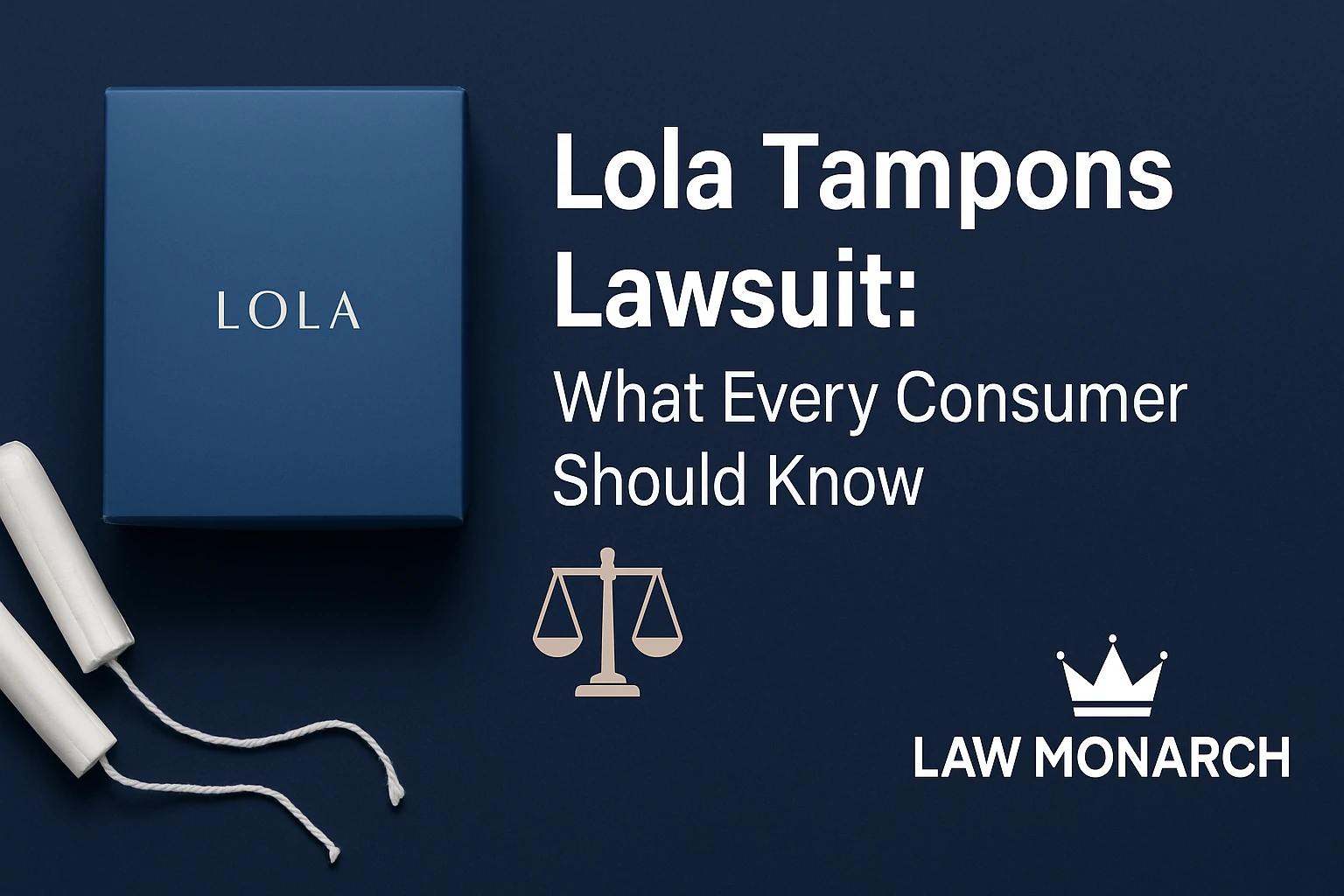Lola entered the market with strong promises. The brand said its tampons were safe, clean, and free from harmful chemicals. It claimed to use only organic cotton. Its look and message attracted many women who wanted a better choice.
Buyers across the country trusted the brand. They believed the products were natural and honest. Many chose Lola over larger names. They wanted fewer risks and more control over their health.
Over time, reports of pain, reactions, and strange symptoms began to appear. Women shared stories online. Some filed complaints. Others took legal action. These cases raised questions about the company’s claims.
This article explains the lawsuit against Lola tampons. It shows what led to the case, what users reported, and how it may affect your health and rights.
What Is the Lola Tampons Lawsuit About?
The lawsuit says Lola tampons may not be as safe as the company claimed. It argues that Lola made false promises about the product. The brand said the tampons were made with 100% organic cotton and had no synthetic materials.
Some users reported health problems after using them. They shared stories of pain, discomfort, and infection. Lawyers say the tampons may have included unknown substances not shown on the label. This raises serious questions about safety and honesty.
The case looks at two main issues. First, did the tampons cause harm? Second, did the company mislead buyers? The court will review both parts to find the truth.
Claims Made Against Lola
Plaintiffs say they suffered health issues that began after using Lola tampons. They link those symptoms to substances that may have been in the product. Some tests suggest the presence of polyester or undisclosed materials.
The legal team claims the company failed to warn buyers of possible risks. They also argue the brand violated consumer protection laws. If proven, this could show that Lola misled its customers for profit.
The lawsuit also claims the company broke consumer trust. Many women picked Lola because it promised clean and honest care. If the brand failed to keep that promise, it could face fines and lose public support.
What Products Are Involved?
The lawsuit covers different types of Lola tampons. These include regular, super, and super-plus options. Most complaints involve products sold between 2018 and 2022.
Many customers ordered these tampons through Lola’s website or monthly box. The company said the products were safe for daily use. Some women used them for years before any issues appeared.
If you had health problems after using these tampons, check the product box or date. Your batch may be part of the case.
Health Concerns Raised by Users
Many women reported pain, dryness, itching, or strange discharge. Some visited doctors and found infections they had never had before. Others noticed changes in their cycle after using Lola tampons.
The lawsuit links these issues to hidden materials or weak product safety checks. It also raises concern about how the company picked and tested its cotton.
Experts agree that natural products can still cause side effects. But when a brand promises safety and purity, people expect no harm. The lawsuit claims Lola broke that trust.
Marketing Claims Under Fire
Lola promoted its tampons as “100% organic cotton.” The company also said it did not use bleach, synthetics, or dyes. These claims made many customers feel safe and confident.
The lawsuit says these claims may not be fully true. If any synthetic material entered the product, even in trace amounts, the ads could be misleading. That would violate trust and consumer laws.
Regulators and courts now look at how the company tested its products. They also want to know if Lola followed strict labeling rules. This will play a big role in the case’s outcome.
What the Company Has Said
Lola has denied any wrongdoing. The company says its products meet high standards. It stands by its claim that it uses organic cotton and keeps its tampons safe.
As of now, no full recall has happened. The company continues to sell its products online. It also offers refunds to some customers, depending on their complaints.
Lola’s legal team is working to defend the brand. They argue that individual reactions do not prove the product is unsafe for everyone.
Legal Path Ahead
The lawsuit may take months or years to settle. Courts will look at product samples, medical reports, and company records. Both sides will present expert testimony.
The case could lead to a class action. That would let many customers join one large case. If this happens, thousands of users may seek refunds or damages.
Settlements may include money for medical costs, refunds, or penalties for false ads. The court may also require the company to change its labels or marketing.
What Consumers Should Do
If you used Lola tampons and had health issues, keep your records. Save product boxes, receipts, and medical notes. You may need these later if you join the case.
Speak with a doctor if you had symptoms. A medical report helps prove your experience. You can also talk to a consumer lawyer who handles product claims. Many offer free consultations.
Even if you had no issues, stay informed. Follow news updates and check for official court notices. You may qualify for benefits if the case turns into a class action.
If you’re looking for trusted legal support in similar cases, the Chris Doherty Law Office in New Hampshire shows how a clear legal strategy can guide clients through complex product claims.
How This Lawsuit Affects Brand Trust
This case shows how trust plays a big role in product choice. Women trusted Lola because of its clean branding and bold claims. A lawsuit can damage that trust quickly.
The company may win in court, but its public image could still suffer. People now want clear proof, honest labels, and strong product checks from every brand.
This lawsuit may also push other companies to test more often and label more clearly. It reminds the public to ask questions and read product labels with care.
Legal cases can damage public trust fast, even without a final verdict. The Arias Agencies lawsuit is another recent example where consumer concerns led to serious legal action.
Conclusion
The Lola tampons lawsuit brings up strong concerns about safety, health, and truth in branding. It shows how fast a company can lose trust when it fails to meet its promises. Many women chose Lola because they believed in the product. They wanted a safer, more honest option. Instead, some say they faced harm.
The case is still open. More facts may come out as lawyers dig deeper. Both sides will present their case in court. Still, one point stands firm. Products made for the body must be safe. They must match the words printed on the label. Hidden risks have no place in personal care.
If you used Lola tampons and felt side effects, take it seriously. Visit a doctor. Keep records. Speak to a lawyer who handles product safety cases. One voice can start change. Many voices can hold companies accountable.
Always stay alert. Check every product before you use it. Read the box. Look at the label. Ask hard questions. Do not trust bold claims without proof. Your body deserves full honesty. Your health should never come second.
Related Post: Anderson Law firm in Austin, Texas
Common Questions About the Case
Q. What started the Lola tampons lawsuit?
The lawsuit began after many users reported health problems they linked to Lola tampons. These included pain, itching, and possible infections.
Q. What claims are made in the case?
Lawyers say Lola tampons may contain hidden materials not listed on the label. They also argue the company used false marketing to gain customer trust.
Q. Can people still buy these products?
Yes. Lola still sells its tampons online. There has been no full recall. The company says its products remain safe and meet quality standards.
Q. What should I do if I used these tampons and had problems?
Keep all records. Visit a doctor. Speak with a product liability lawyer. You may qualify for help if the case becomes a class action.
Q. Is this a class action lawsuit?
Not yet. But it may become one. If approved, many users can join the case to seek refunds or medical costs.
Disclaimer
This article is for general information only. It does not give legal or medical advice. Do not rely on this content as a substitute for speaking with a licensed attorney or healthcare provider. Each case is different. Always talk to a qualified expert about your personal situation.




